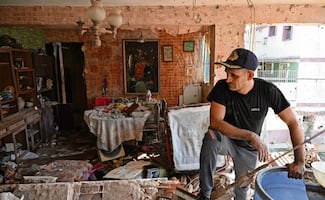Más Información

Petro aguarda traducción para responder a "amenaza ilegítima de Trump"; si detienen al Presidente, desatarán al jaguar popular, asegura

Venezuela, trampolín para el tráfico internacional de cocaína; así permitió Nicolás Maduro el paso de esta droga, según EU

Viralizan video de Petro retando a EU grabado en noviembre; pedía a Trump meterlo preso "a ver si puede"
Inhabitants of San Lorenzo de las Bayas y de Ocampo, Tamaulipas were performing construction works when they noticed on July 8 the presence of human remains, so they looked for experts of Mexico’s National Institute of Anthropology and History (INAH), who performed salvage works.
The bone remains correspond to a man between 21 and 35 years old who could have lived during the Classic period, between the years 400 and 700 A.D., and who was put inside a rucksack next to a small molcajete as an offering.
The discovery is highly relevant, according to INAH experts, because it is one of the first pre-Columbian human burials reported as “complete,” outside dry caves, in the natural área known as Southwestern Tamaulipas.
Physical anthropologist Jesús Velasco González and archeologist Vanueth Pérez Silva added that they were notified by locals on July 8 and, two days later, they went to San Lorenzo – a community locate north of the Pamería and the Huasteca, and connected by a 40-km unpaved road to Ocampo, to recover the cultural heritage.
Recommended:
Velasco explained that the bones and the molcajete that were found were completely salvaged and that the skeleton is seated and bent position, so it is thought that the young man was put inside a funeral bundle.
Archeologist Vanueth Pérez mentioned that the only object linked to the deceased was the molcajete, which could date from the region’s Classic period, between 400 and 700 A.D.
For now, the cultural heritage is being studied at the Osteology Laboratory of the Tamaulipas INAH Center. The experts mentioned that since the remains were recovered through archeological salvage, future field seasons will need another intervention, therefore, they are considering studying the context through the Tamaulipas Biocultural Mortuary Caves project or the Southwestern Tamaulipas Archeological project.
Recommended:
Likewise, they added that according to their observations during the salvage, there are at least two more burials near the site; however, those were not compromised by the construction works, so they have remained in situ with the help of the local community.
mp
Noticias según tus intereses
[Publicidad]
[Publicidad]











